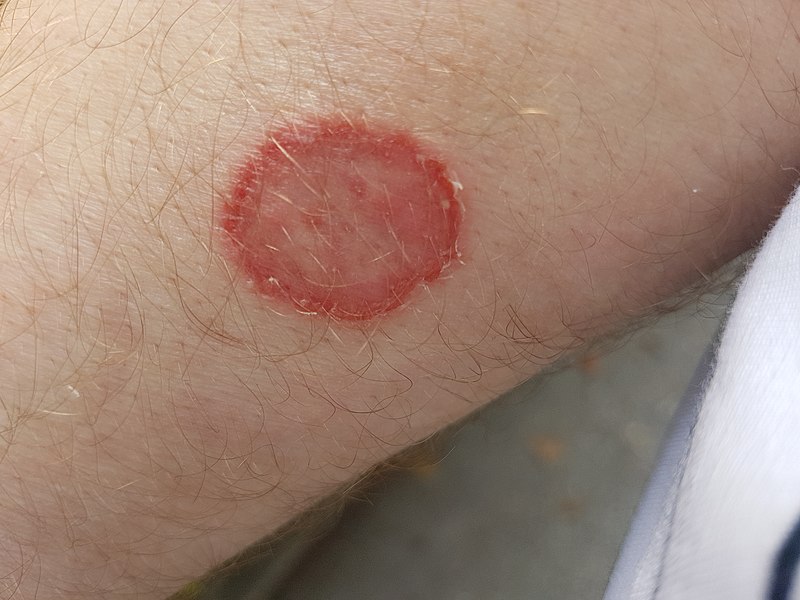What is the Difference Between Bacterial and Fungal Skin Infection
The key difference between bacterial and fungal skin infection is that bacterial skin infection appears as small red bumps, which later increase slowly in size, while fungal skin infection appears as scaly, itchy rashes, or discoloration of the skin
Skin is the largest organ of the body. Its main function is to protect the body from infections. However, the skin sometimes becomes infected due to various pathogens. Normally, skin infections are caused due to various types of germs such as bacteria, fungi, and viruses. The symptoms may vary from mild to serious. Mild symptoms are treated by over-the-counter medications and home remedies. However, the serious symptoms require medical attention. Bacterial and fungal skin infections are two common types of skin infections.
CONTENTS
1. Overview and Key Difference
2. What is Bacterial Skin Infection
3. What is Fungal Skin Infection
4. Similarities – Bacterial and Fungal Skin Infection
5. Bacterial vs Fungal Skin Infection in Tabular Form
6. Summary – Bacterial vs Fungal Skin Infection
What is Bacterial Skin Infection?
Bacterial skin infection is caused due to invasion of the skin by bacteria. Bacterial skin infection normally starts as small red bumps, and later it increases slowly in size. Bacterial skin infection is fairly common in society. Some bacterial infections are mild and can be easily treated with topical antibiotics. Other bacterial skin infections are life-threatening. Therefore, serious infections need oral antibiotic prescriptions from a certified medical practitioner. Dermatologists and rheumatologists treat more complicated skin infections.

Figure 01: Bacterial Skin Infection – Cellulitis
Most of these bacterial skin infections are caused due to Staphylococcus aureus and Streptococcus pyogenes. In most complicated cases, bacterial skin infections can spread from the skin to the bloodstream. This condition is called septicaemia. Septicemia is a life-threatening condition. The most common bacterial skin infections are cellulitis (caused by Staphylococcus or Streptococcus), erysipelas (caused by Streptococcus), bacterial folliculitis (cause: Pseudomonas), furuncles (Staphylococcus), carbuncles (Staphylococcus), impetigo (Staphylococcus or Streptococcus), erythrasma (Corynebacterium minutissimum), and MRSA skin infection (Staphylococcus). The current antibiotic treatments recommendations for bacterial skin infections are penicillinase-resistant penicillins, cephalosporins, azithromycin, clarithromycin, amoxicillin-clavulanic acid, and fluoroquinolone.
What is Fungal Skin Infection?
Fungal skin infection is caused due to the invasion of the skin by fungi. There are about 300 fungal species that can cause skin infections. Fungi live everywhere. They can be found in plants, soil, and even on the skin. They typically do not cause any invasion of skin. However, they can multiply faster than the normal rate or penetrate the skin through a cut or lesion. As fungi prefer warm and moist environments, fungal infections are developed in areas of the body such as feet, groin, and folds of skin, which do not get much airflow. These infections typically appear as scaly, itchy rashes or discoloration of the skin.

Figure 02: Fungal Skin Infection
Fungal skin infections are not serious. Some popular fungal infections are ringworm of the body (Tinea coporis), athlete’s foot (Tinea pedis), jock itch (Tinea cruris), ringworm of the scalp (Tinea capitis), fungal/yeast skin infection (Tinea versicolor), cutaneous candidiasis (Candida), and onychomycosis (Tinea unguium). Furthermore, treatments include over-the-counter antifungal medications such as creams (ointments), pills, powders, sprays, and shampoos.
What are the Similarities Between Bacterial and Fungal Skin Infection?
- Bacterial and fungal skin infections are two common types of skin infections.
- These medical conditions are caused due to overgrowth and invading of normal skin microorganisms through cuts, burns, and lesions.
- Both medical conditions can be treated with over-the-counter (OTC) medications.
- These skin infections are treated by dermatologists.
What is the Difference Between Bacterial and Fungal Skin Infection?
Bacterial skin infection is a condition caused due to invasion of the skin by bacteria, while fungal skin infection is a condition caused due to invasion of the skin by fungi. Bacterial skin infection appears as small red bumps, and later, it increases slowly in size, but fungal skin infection appears as scaly, itchy rashes or discoloration of the skin. Thus, this is the key difference between bacterial and fungal skin infection
The below infographic presents the differences between bacterial and fungal skin infection in tabular form for side by side comparison.
Summary – Bacterial vs Fungal Skin Infection
Skin becomes infected due to various pathogens such as bacteria and fungi. They are caused due to the over-growth and invading of normal skin microorganisms through cuts, burns, and lesions. Bacterial skin infection appears as small red bumps, which later increase slowly in size, while fungal skin infection appears as scaly, itchy rashes or discoloration of the skin. So, this is the key difference between bacterial and fungal skin infection
Reference:
1. Stulberg, Daniel L., et al. “Common Bacterial Skin Infections.” American Family Physician, 1 July 2002.
2. Seladi-Schulman, Jill. “Fungal Skin Infection: Types, Treatment, Prevention.” Healthline, Healthline Media, 7 Jan. 2020.
Image Courtesy:
1. “Cellulitis Of The Leg” By Pshawnoah – Snapped a cell phone image (CC BY-SA 3.0) via Commons Wikimedia
2. “Dermatophytosis 20190815-02ASD” By Asurnipal – Own work (CC BY-SA 4.0) via Commons Wikimedia
ncG1vNJzZmivp6x7pbXFn5yrnZ6YsqOx07CcnqZemLyue9ahmK1lmah6tbTEZpuinpaav6a6wp5km52krLKmuoybmJyslae2oriMmqWdZZaqu6ity2aqpKGeYravssScq6KnnmQ%3D